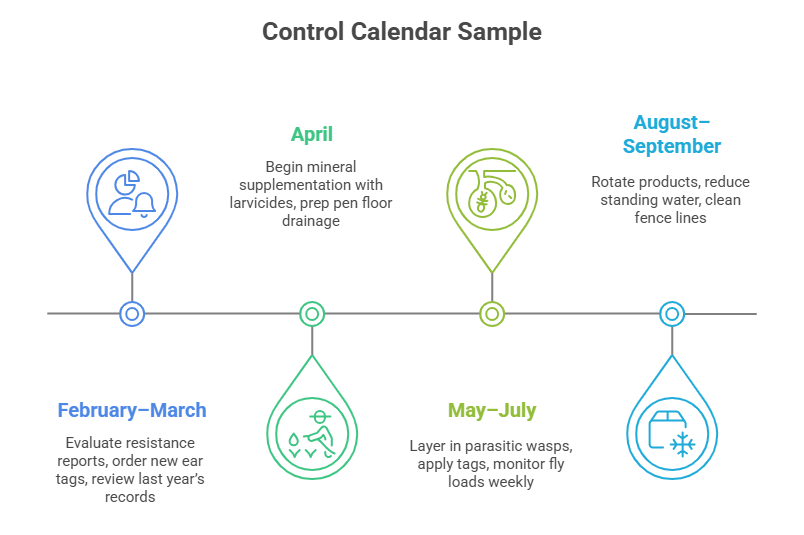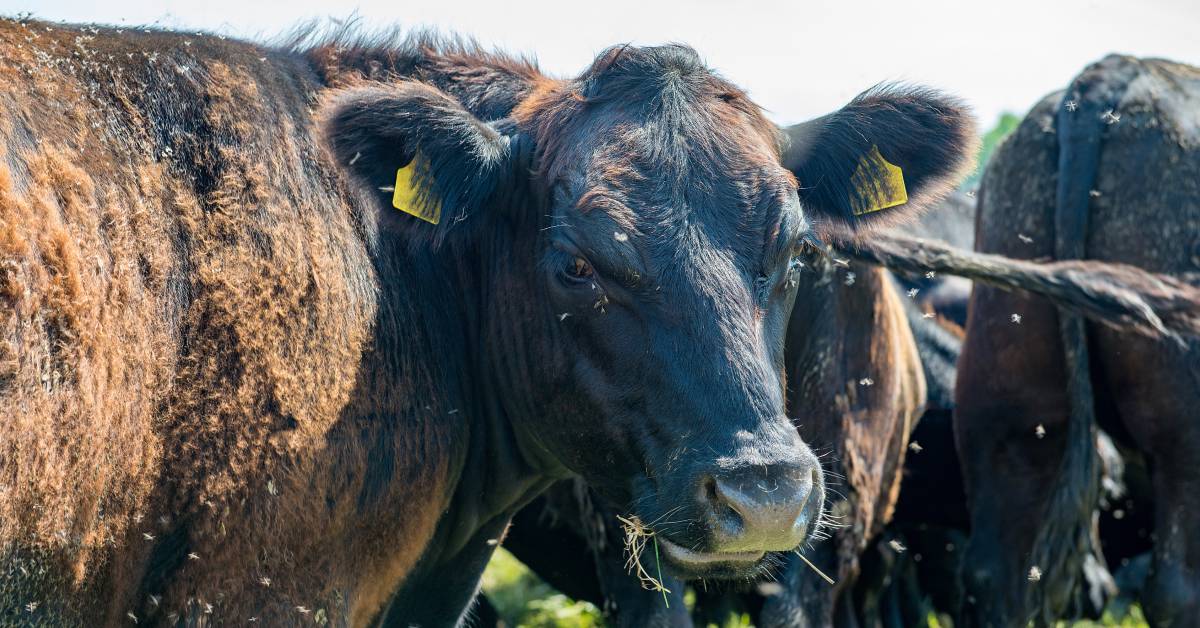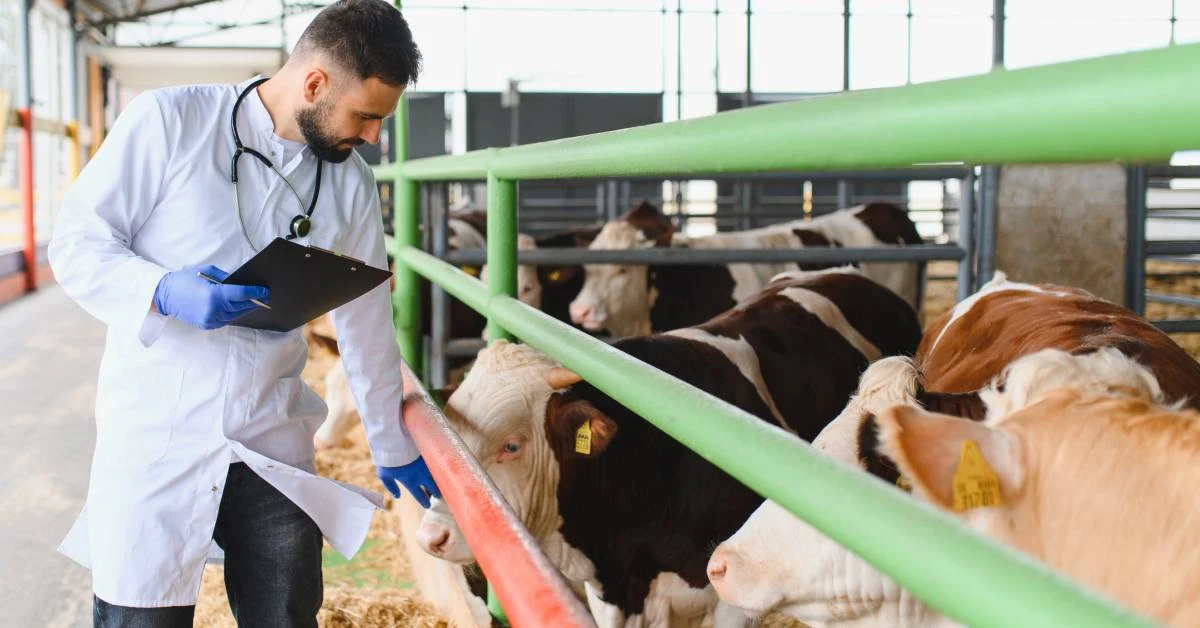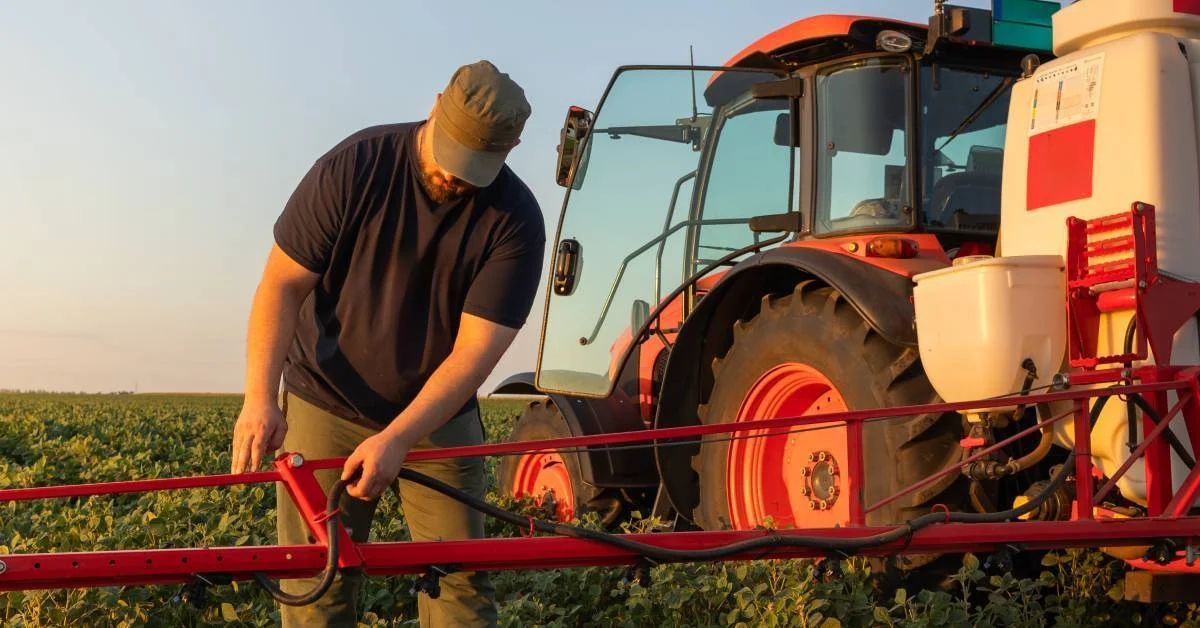By mid-summer, it’s not uncommon for untreated cattle to carry 200–500 horn flies per head. That’s not just discomfort, it’s a measurable loss in weight gain, feed conversion, and, in severe cases, rising morbidity due to pinkeye and stress-induced health setbacks. For reference, horn flies surpassing 200 flies per animal is widely recognized as the Economic Injury Level, leading to decreased weight gain and milk production, and costing U.S. producers over $1 billion annually.
The problem compounds in high-density feedlot environments, where moisture, manure accumulation, and bunk proximity make ideal breeding grounds for fly populations. And while most yards acknowledge the issue, far fewer have a consistent, multipronged cattle fly control strategy in place, one that prevents resistance, protects performance, and adapts to seasonal pressures.
This blog breaks down what works in modern cattle fly control, what has been tested, what brings ROI, and what prevents resistance buildup.
The Real Cost of Cattle Flies in Feedlot Operations
How Feedlot Environments Invite and Sustain Fly Infestations
Feedlots are designed for efficiency, but the same features that support high-density cattle management also make them ideal breeding grounds for flies. Manure buildup, compacted wet surfaces, and leftover feed create persistent moisture and organic residue, exactly what horn flies, stable flies, and face flies need to thrive.
These aren’t occasional pests. They’re highly adaptive, fast-replicating insects that exploit the smallest lapse in pen hygiene or drainage. Horn flies, for instance, can complete a life cycle in under 10 days. That means a missed clean-up or a single overlooked pile of manure can turn into tens of thousands of new flies in less than two weeks.
In a pasture, cattle can walk away. In a feedlot, they can’t. And this is where the challenge escalates. Cattle that are unable to escape irritation exhibit persistent discomfort, leading to feeding disruptions, social stress, and even increased susceptibility to illness. Without proactive cattle fly control, these stressors accumulate quickly, undermining herd performance even before visible symptoms show up.
How Flies Disrupt Feeding Behavior, Health, and Pen Efficiency
The most damaging effects of flies often go unnoticed until they’ve already reduced weight gain or uniformity across pens. Feedlot cattle respond to persistent fly irritation in ways that ripple through your entire operation:
- Reduced bunk attendance: Flies around the head and shoulders lead cattle to avoid head-down feeding. Even a 5–10% decline in bunk time impacts feed-to-gain efficiency.
- Increased energy waste: Stomping, tail switching, pacing, all of it burns calories that would otherwise go to growth.
- Inconsistent group behavior: Cattle may start bunching together in corners or shadows. Dominant animals block the timid ones, leading to uneven feed access.
- Fly-induced health setbacks: Stable flies and face flies exacerbate pinkeye outbreaks, slow down BRD recovery, and worsen open wounds.
Each of these changes might look minor in isolation, but they compound over a full cycle. And unless you’re linking these behavioral patterns back to fly loads, they’ll be misattributed to weather shifts or bunk management errors.
If you’re building a tighter feedback loop between behavior, intake, and condition scoring, integrating digital checklists in beef feedlots can help you identify performance drags earlier, especially when tied to fly activity patterns or pen-specific health records.
What Ignoring Flies Is Costing Your Feedlot
There’s a tendency in the industry to treat fly problems as seasonal or cosmetic, something that comes and goes with the weather. But every year, operations that take this approach leave profit on the table.
Let’s break down where those losses show up:
- Longer days on feed: When cattle spend more time fighting flies than eating, they finish later. That’s added feed, water, and labor.
- More pulls and treatments: Fly stress worsens the immune response. A pinkeye case that could have been avoided now requires vet time, medication, and labor to contain.
- Weight variability at close out: Inconsistent feed access leads to pens finishing unevenly, increasing sorting time and compromising packer relationships.
- Chemical resistance build-up: Poor fly management leads to repeated application of the same sprays. Diminished efficacy, more expense, and fewer options next season.
Operators who prioritize a fly control cattle strategy that’s systematic, pen hygiene, early mineral support, and chemical rotation are seeing real returns: smoother feed curves, fewer health surprises, and tighter finish windows.
For those already optimizing feed conversion and finish uniformity, layering fly management into your broader plan for herd performance is a no-brainer. If you’re serious about maximizing margins, this guide to optimizing feedlot operations outlines exactly how to align environmental, nutritional, and health data in your favor.
Effective Tactics for Cattle Fly Control
The success of any feedlot doesn’t just depend on ration design, pen maintenance, or handling efficiency. It’s the invisible, often overlooked elements, like fly pressure, that compound into measurable profit loss over a cycle. And while many operations reach for pour-ons or chemical sprays as a default response, truly effective cattle fly control demands more discipline, structure, and systems thinking.
1. Start With the Lifecycle
Most fly control programs fail because they respond to adult flies after infestation, rather than targeting the larval stage before population booms. Horn flies, for instance, spend most of their lifecycle in manure as pupae. If your control effort begins after they’re flying, you’ve already lost the performance window.
Flies need moisture + organic matter. Remove either, and the lifecycle collapses.
Key Actions:
- Pen floors should dry within 12–18 hours after rainfall or hosing.
- Bunk spill zones should be cleaned weekly.
- Scrape and relocate manure piles every 5–7 days.
2. Integrate Feed-Through Larvicides
Feed-throughs like methoprene and diflubenzuron work best when introduced before fly populations spike, typically 4–6 weeks before the warm season fully kicks in. These additives pass through the animal and interrupt the development of fly larvae in manure without harming dung beetles or rumen microbes.
| Product Type | Mode of Action | Timing Required | Notes |
| Methoprene (IGR) | Prevents larval pupation | Early spring | Pair with bunk cleaning |
| Diflubenzuron | Inhibits chitin synthesis | Mid-spring | Requires daily intake |
| Cyromazine (less common) | Larval death | Rotation option | Watch regional use limits |
3. Layer In On-Animal Solutions, But Rotate Chemicals
A mistake many yards make is applying the same class of insecticide year after year. Resistance builds fast, and the same pyrethroid tag that worked in 2020 may now offer little more than a placebo effect.
Rotation tips:
- Don’t mix chemical classes mid-season; rotate annually, not monthly.
- Alternate between pyrethroids, organophosphates, and spinosyns.
- Choose ear tags with removal schedules (usually 90 days) to avoid prolonged low-dose exposure.
Note: On-animal treatments like back rubbers or dust bags are most effective when strategically placed near water or exit alleys where cattle naturally pass.
4. Data & Daily Logs For Fly Control Program
One of the most underutilized fly control tools is pen-level observation data. By logging fly load counts, treatment dates, weather shifts, and manure conditions, you build a feedback system that sharpens timing and identifies what’s working and what isn’t.
A robust livestock record-keeping system not only simplifies treatment plans but also improves accountability across your crew. With digital tools, yards can log pour-on application per pen, record mineral intake trends, and flag hotspots where sanitation isn’t keeping up.
5. Biological Controls
If you’ve been on the fence about integrating parasitic wasps (like Spalangia endius), here’s the short version: they work, and they’re cost-effective. These wasps don’t bite cattle, they lay eggs inside fly pupae in manure, killing the fly before it ever hatches.
Best practice:
- Start releases in early spring and continue every 2–3 weeks.
- Focus on high-density manure zones (bunk lines, water trough perimeters).
- Don’t spray residual insecticide near wasp release zones.
While biological agents don’t eliminate the need for chemical or feed-through options, they stabilize fly populations and extend the efficacy of your other control layers.
6. Account for Vulnerable Groups
Younger animals are disproportionately affected by fly irritation. Their immune systems are still developing, and reduced bunk time can quickly lead to shrinkage or delayed gain recovery. That’s why targeted application of fly control for cows and calves in nursery and hospital pens should not follow the same schedule as the main yard.
Use lighter dose insecticides in calf areas, or consider non-chemical deterrents (fans, screens, fly traps). Calves also benefit from expert feedlot handling practices like isolated feeding zones that keep manure from accumulating where they bed.
7. Use Seasonal Planning
Effective cattle fly control starts before flies arrive. Build your calendar backward from your region’s peak fly season. Spring prep should include manure pile relocation, mineral planning, and biological release scheduling.

When fly control aligns with data, record keeping, and operational planning, it becomes more than a chore. It becomes a lever for daily performance stability and end-of-cycle profitability.
How Folio3 AgTech’s Feedlot Management Software Supports Fly Control Efforts
In feedlot environments where labor is stretched, routines are fast-paced, and weather conditions shift rapidly, manual oversight alone isn’t enough to sustain control. That’s where digital systems come in, not to replace decisions, but to strengthen them.
Folio3 AgTech’s Feedlot Management Software is designed to support operational workflows that directly enhance fly control performance without ever being a “fly control tool” on the surface.
1. Real-Time Livestock Health Monitoring & Alerts
The software integrates with RFID tags, biometric sensors, and third-party diagnostics to continuously track cattle health at the individual and pen level. Patterns like increased pacing, clustering near shaded areas, or early signs of pinkeye can be linked to rising fly activity, often before it’s visible.
How it helps cattle fly control: Early alerts let managers take targeted action, whether that’s mineral adjustment, isolating high-risk pens, or advancing spray schedules, before fly loads hit economic thresholds.
2. Feed & Waste Optimization to Reduce Breeding Grounds
The system helps you dial in rations, manage feed inventory, and reduce waste buildup. It flags leftover feed, moisture levels, and bedding saturation that often go unnoticed, but are exactly where horn and face flies breed.
How it helps cattle fly control: Reducing moisture-rich zones means fewer breeding sites. The software’s feed tracking and waste alerts ensure fly habitats are removed before they escalate.
3. Labor Scheduling for Sanitation Protocols
The system enables role-based labor scheduling and assigns recurring tasks like pen cleaning, drainage checks, and larvicide application. Every action is timestamped, tracked, and visible to management.
How it helps cattle fly control: Instead of depending on memory or clipboard routines, sanitation becomes a structured workflow. No missed cleanouts. No delays in treatment. Just consistent prevention.
4. Behavioral and Intake Monitoring for Early Detection
By combining growth data, feed intake, and behavior mapping, the software detects subtle shifts, like reduced eating, slower gain, or crowding patterns, all of which can be early markers of fly irritation.
How it helps cattle fly control: These signals allow for faster intervention without relying on visual observation alone. You catch fly-related stress before it turns into lost performance.
5. Built-In Record-Keeping for Treatment and Compliance
Fly control treatments, from pour-ons to antibiotics for pinkeye, often require documentation for audits, QA checks, or VFD logs. Folio3 tracks every application, product used, dosage, and pen or lot ID automatically.
How it helps cattle fly control: Staying audit-ready becomes part of daily ops. It also prevents overuse of treatments, avoiding resistance buildup that makes fly control harder season after season.
This is the kind of digital infrastructure that enables mid-size and large feedlots to stay ahead of pressure points like fly infestations, not through marketing promises, but through operational alignment.
Conclusion
What separates effective yards isn’t just the tools they use; it’s how early they act, how well they adjust, and how closely they monitor what’s working. This blog should give you a clearer framework: target the larval stage before flies peak, rotate your approach to avoid chemical burnout, and treat fly management as part of your broader health, feed, and facility plan, not an isolated task.
Where many feedlots fall short isn’t in effort, it’s in coordination. You can apply the right products at the wrong time and still lose ground. You can clean pens, but miss a hotspot that keeps reinfecting the yard. That’s why feedlots using integrated systems, tracking mineral intake, logging fly counts, and aligning treatments with pen behavior, aren’t just seeing fewer flies; they’re seeing fewer surprises.
FAQs
How can feedlot management software help control flies in cattle?
Feedlot management software supports fly control by automating task scheduling, tracking treatment history, and logging pen-level fly pressure. It enables the timely execution of sanitation, treatment, and mineral intake protocols, ensuring no steps are missed. By integrating health and feed data, it helps align fly control with broader herd management goals.
What are the most effective methods for controlling flies on feedlots?
The most effective fly control methods include:
-
- Timely application of feed-through larvicides
-
- Regular pen cleaning and moisture management
-
- Strategic use of insecticidal fly tags and sprays
-
- Biological control (e.g., parasitic wasps)
-
- Use of physical barriers and targeted treatment in high-risk zones
How do automated sprinkler systems help control flies?
Sprinkler systems disrupt fly breeding by keeping pen surfaces drier and reducing the buildup of moisture in feed and manure zones. When used strategically, they help prevent eggs and larvae from developing, especially near bunk lines and waterers where fly activity is highest.
How can fly tags help in controlling cattle flies?
Fly tags release insecticide close to the source, on the animal, offering sustained control against horn and face flies. They are most effective when applied just before fly season begins, rotated annually to prevent resistance, and used alongside other control measures like pen sanitation and feed-through larvicides.
What role does data play in managing fly control on feedlots?
Data enables targeted, timely decisions in fly control. By tracking fly counts, treatment effectiveness, pen conditions, and chemical usage, feedlots can optimize when and where to act. It also supports resistance management by identifying overused products and helps measure the ROI of different fly control strategies season over season.
How do I prevent fly resistance from recurring each year?
To prevent fly resistance, rotate insecticides annually and avoid overusing the same product class. Combine this with strong cattle fly control practices like sanitation, feed-through larvicides, and early intervention. A well-structured cattle fly control plan reduces the risk of resistance year after year.







